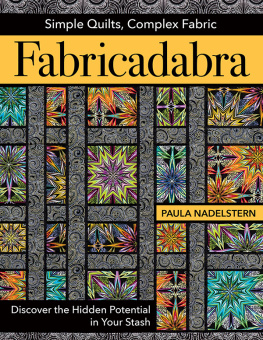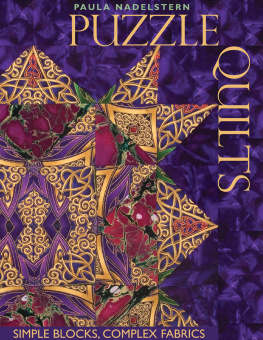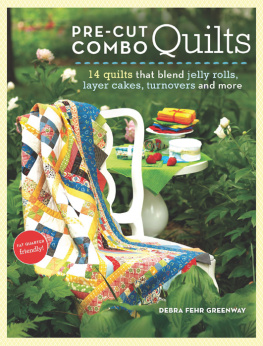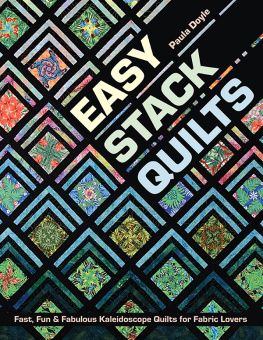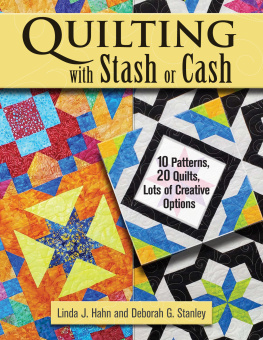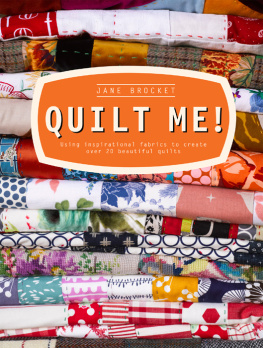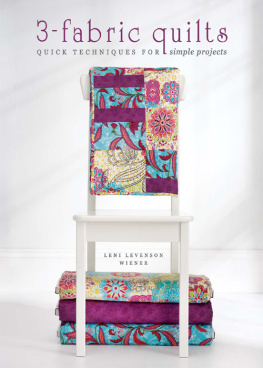Publisher: Amy Marson
Creative Director: Gailen Runge
Editor: Lynn Koolish
Technical Editor: Helen Frost
Cover Designer: Page + Pixel
Book Designer: Kristen Yenche
Production Coordinator: Zinnia Heinzmann
Production Editor: Alice Mace Nakanishi
Illustrator: Tim Manibusan
Photo Assistant: Carly Jean Marin
Instructional photography by Diane Pedersen, unless otherwise noted
Published by C&T Publishing, Inc., P.O. Box 1456, Lafayette, CA 94549
Dedication
To Eric and Ariel, the loves of my life


I think I heard this quote by the patriarch of the Flying Wallenda family on NPR. Essentially he said:
To be on the high wire is to be alive; everything else is waiting.
After months filled with the business of quiltmaking, the moment comes when I step onto my figurative tightrope, setting in motion the act of balancing my life, my fabric, and my technique. The real world hushes and blurs in the background while I wend my way alone, sometimes wobbling and scared that I wont make it, somehow regaining equilibrium. At last, the waiting is over.
Acknowledgments

It was inevitable. My developmental editor informed me that Id used up all my space, and my inner author warned me that Id used up all my words. So heres a simple nod of thanks. Trust me: Its hard for me not to gush and lavish praise, because I appreciate profoundly everything the quilt world did to help me make this book the best it could be.
The quiltmakers and quilters: Marilyn Badger, Benedicte Caneill, Beth Carney, Brenda Crouch, Linda Crouch-McCreadie, Judy Doenias, Helen Frost, John Flynn, Rebecca Gore, Marlene Hiltner, Mary Kay Jansson, Linda Leathersich, Toby Lischko, Claudia Clark Myers, Sue Nickels, Susan Parisi, Elizabeth Rosenberg, Ruthmary Schauer, Ricki Smith Selva, Brenda Shreve, Rebecca Torvinen and Vicki Welsh.
C&T Publishing: Lynn Koolish, Helen Frost, Amy Marson, Kristen Yenche, Zinnia Heinzmann, Alice Mace Nakanishi, Ruthmary Schauer, Roxanne Cerda, Lynn Merrill, Mary Wruck, Deirdre Quirk, Andy LaFaille, and Diane Pedersen.
Benartex: Kay Saniga, Ruth Beck, David Lochner, Susan Neill, Susan Kemler, Belinda Cook, Monique Ortiz, Svetlana Kuperberg, Karen Song, Doreen Valentine, Liz Kolansky, Choe Malsook, Karlos Desalla, Jessica Marano, Jeremy Jeffries, Robert Otero, Rafael Zimbron, Mariell Lantigua, Melanie Greseth, Joanie Holton, and the warehouse staff, and M.H. Park and the Kabool Mill staff.
The Texas Quilters who dubbed themselves Nadelheads, gifting me one of the greatest thrills of my life.
Semper Tedium: Katherine Knauer, Amy Orr, and Robin Schwalb; Julie Echols, who traded a much-needed yard of fabric in class; Shirley Levine, Sanda Balaban, Cat Nix, and Eva Nadelstern; the Manhattan Quilters Guild: Elena Aristova, Ludmila Aristova, Teresa Barkley, Benedicte Caneill, Beth Carney, Mex Cox, Randy Frost, Iris Gowen, Luke Haynes, Tatiana Irvina, Katherine Knauer, Emiko Toda Loeb, Ruth Marchese, Diana Robinson, Robin Schwalb, Paula Sweat, Kim Swoboda, Daphne Taylor, Ludmila Uspenskaya, Arle Sklar Weinstein, Erin Wilson, and Victoria Finley Wolfe; Cathy Izzo and Dale Riehl/The City Quilter; Terri Rodgers/The Cotton Club; Linda Crouch-McCreadie and Brenda Crouch/Tennessee Quilts; Luana and Paul Rubin/Equilter; Ira Merritt/Photographer; Judy Garrison Spahn/Quiltmaker; Julie Silbur/Quilt Dealer.
BERNINA of America for product support; Amy Butler/Rowan; Jane Sassaman/FreeSpirit; Liza Prior Lucy and Kaffe Fassett/Rowan, Evie Ashworth/Robert Kaufman; Jason Yenter and Leah Nelson/In the Beginning; Laura Sutthoff/Coats & Clark; Karla Overland/Cherrywood; Wendy Richardson/Quilt Tapestry Studios; Reece Scannell/Handmade Textiles; Pamela Goecke/Aardvark Quilts; Dierdra McElroy/Roxanne Products; Alex Veronelli/Aurifil; Heather Purcell/Superior Thread; Valerie Mizzoni/WonderFil Specialty Threads; Paula Powers and Peggy Schafer/Prym Consumer USA, and Ed Ras/The Daylight Company.
Eric Nadelstern: You are still welcome.

Introduction
Me, Myself, and My Process
When you work in a series, the questions you ask yourself get more complex but the answers get simpler. I know this because Ive been absorbed in a series of kaleidoscopic quilts since 1987. One of the unplanned perks of this kind of focus is sudden intuitive leaps of understandingactual breakthroughs to new and deeper perspectives on problems you (sometimes) didnt even realize needed to be resolved. It feels as if, out of the blue, effortlessly, you now know something essential that you did not know the second before. The feeling is both surprising and fulfilling because you intuitively understand that the new knowledge will forever be part of your arsenal of design strategies.
This book is the result of one of my internalized eurekas. I realized I could, in a word (rare for me), simplify. Take the complex quilts Ive made and pare them down to their essential bones. Take traditional quilts and gift wrap their simple shapes with intricate fabric.
Quilts made of simple shapes can be transformed into visual spectacles that read as complex, thoughtful acts of creativity. The quilts showcased in this book may look difficult and complicated, but ultimately they are not when you know how to look for the seams. The text distills 30 years of quiltmaking into simple theories that explain my way of thinking about quiltmaking processes. Along with other design elements, youll explore the possibilities offered by intricate, charismatic textiles while I attempt to demystify the nature of symmetry.
Please understand that the quilts in these pages are simple, but that doesnt necessarily make them easy. Theres a difference.
Simple: Easily understood or done
Easy: Not requiring much effort, work, or thought
Be patient. Dont accept a solution if you dont like it. If you dont like it now, you wont like it when the quilt is finished. It always takes longer than youd expect to design something good. Designing goes forward and back and wanders around in all directions. You dont always find yourself in a fun place. But ultimately, the act of creating is a satisfying, if sometimes laborious, process. (Its no secret that Im one of those who celebrates artwork created in as much time as it takes. But just because how long it takes doesnt matter to me doesnt mean you shouldnt figure out how to get there faster.)
Ive noticed that quilters at every skill levelmyself includedthink the only time they are truly productive is when they are physically at the sewing machine. But all kinds of time are necessary parts of the process: looking, musing, revising, tinkering, screwing up, constructing, and deconstructing.
Sometimes you just have to coax inspiration. Typically, when I am stuck I dive into piles of fabrics and grab the ones that trigger what-if questions. I try to quash preconceived notions of what goes with the choices Ive made so far. Reevaluating your choices is an extension of the problem-solving skills you use every day. Hopefully the process does not involve a trip to the fridge.
Becausecircling back to the narrative I started withthe takeaway is that breakthroughs are more mundane than the idea of a magical epiphany might suggest. It may be magical but its not magic. You have to put in the time. New insights come when the mind is primed. Rather than being spontaneous and unprompted, they follow a process of significant, even if unconscious, thought about a problem. It may be simple but it doesnt come easy.
Next page
